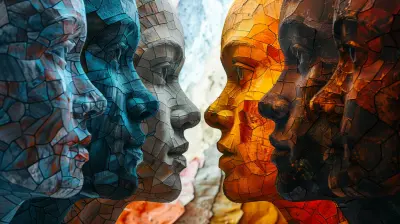The Impact of Mental Health Stigma on Adolescents and Teenagers
7 October 2025
Mental health has finally started gaining the attention it deserves. But let’s be real—there’s still a huge elephant in the room: stigma. And when it comes to adolescents and teenagers, that stigma can be powerful, painful, and often invisible. This article dives deep into how mental health stigma affects young people, how it messes with their heads (and lives), and what we can do to turn things around.

What Exactly Is Mental Health Stigma?
Let’s strip it down. Mental health stigma is that cloud of shame, judgment, and misunderstanding that looms over people dealing with mental health issues. It’s the belief that having anxiety, depression, ADHD, or anything else mental-health-related means you're "weak," "crazy," or "attention-seeking."Now, imagine being a teenager—already juggling hormones, high school, social media, friendships, and figuring out who you are—while carrying that stigma on your back. It’s like running a marathon with lead boots.

Why Teenagers Are Especially Vulnerable
Teenagers are in one of the most awkward and sensitive stages of human development. They’re trying hard to fit in but also stand out. They want independence but still desperately seek validation. Throw a mental health struggle into the mix, and the shame can be overwhelming.Think about it: If a teen admits they’re depressed, they might fear being labeled as “dramatic” or “emo.” If they have anxiety, people might say they’re just being “extra.” That fear pushes them into silence—and silence is where stigma thrives.

The Different Faces of Stigma
Stigma doesn’t just come in one flavor. It's sneaky and shows up in different forms. Let’s break it down:1. Self-Stigma
This is when teens internalize society’s negative attitudes. They start thinking:“I must be flawed.”
“I should just suck it up.”
“I don’t deserve help.”
When young people believe these lies, it eats away at their self-worth and stops them from reaching out for help.
2. Public Stigma
Public stigma is what we usually picture—social rejection, name-calling, discrimination. Teens may be called “crazy,” “psycho,” or “unstable.” This kind of labeling is toxic and damaging.3. Institutional Stigma
Yep, even schools and health systems can contribute. Lack of school counselors, outdated policies, and general ignorance about mental health all compound the problem. Sometimes, even when a teen finally reaches out, they hit a brick wall of red tape or indifference.
How Stigma Messes With Mental Health
Mental health stigma doesn’t just hurt feelings—it has real, serious consequences. Here’s how it messes things up:A. Delays in Seeking Help
When teens feel like they’ll be judged, they keep their struggles bottled up. According to some studies, adolescents can wait months—sometimes even years—before reaching out. And the longer mental health issues go untreated, the more severe they become.B. Increased Feelings of Isolation
Nothing feels worse than thinking you’re all alone in your pain. Stigma feeds that loneliness. Teens may withdraw from friends, cancel plans, or avoid school. Isolation becomes a breeding ground for deeper anxiety, depression, and in extreme cases—even suicidal thoughts.C. Academic and Social Decline
Mental health struggles already make it hard to concentrate or maintain relationships. Add stigma into that mix, and a teen might stop participating altogether. Grades drop. Friendships fade. Self-esteem tanks.D. Self-Harm and Risky Behavior
Some teens, overwhelmed by unspoken pain, turn to self-harm or risky behaviors as a coping mechanism. These are cries for help, but stigma often masks those cries in shame and secrecy.Real Talk: What’s Fueling the Stigma?
Stigma isn’t just a random thing—it’s passed down and reinforced by culture, media, and even family.1. Outdated Beliefs
Some families still hold the belief that mental illness is a sign of weakness or poor upbringing. Teens raised in this environment are less likely to talk about their feelings openly.2. Media Stereotypes
Movies, TV shows, and even TikToks sometimes portray people with mental illnesses as violent, unstable, or weird. Teen brains are still forming, and these portrayals stick—whether they're realistic or not.3. Peer Pressure and Social Media
In the age of Instagram and Snapchat, teens are hyper-aware of how they’re perceived. No wonder they’re paranoid about opening up. Nobody wants to be the one labeled “damaged goods” in the group chat.
The Ripple Effects: Stigma Doesn’t Just Stay in the Mind
We often forget this, but mental health stigma has ripple effects that impact pretty much every area of a teen’s life:- Home Life
Stress increases. Family dynamics become strained. Teens may feel like they can’t talk to their parents, or worse, that they’re a burden.- School Environment
From teachers labeling them as “troublemakers” to classmates excluding them, school can turn into a war zone for teens dealing with mental health stigma.- Physical Health
Yup, mental health affects physical health too. Chronic stress can lead to headaches, fatigue, stomach issues, and a weakened immune system. It’s all connected.Breaking the Cycle: So, What Can We Do About It?
Let’s flip the script. Ending stigma isn’t impossible. It just takes courage, conversation, and consistency—especially when it comes to our teens.A. Normalize Mental Health Conversations
The more we talk openly about mental health, the less scary it becomes. Start with simple check-ins. Ask, “How’s your mental health?” like you’d ask about someone’s day.B. Educate (Without the Lecture)
Schools need to create curriculums that treat mental health like any other health issue. But parents, friends, and communities can also step up. Share resources, stories, and even memes that offer real insight.C. Highlight Role Models
There are tons of celebrities and influencers opening up about their mental health. Sharing their stories can help teens see that struggling doesn’t mean failing.D. Safe Spaces and Support Networks
Whether it’s school counselors, online communities, or peer support groups, teens need places where they can speak freely without fear of judgment.E. Therapy Without the Taboo
Let’s kill the myth that therapy is only for “crazy” people. Going to therapy is like going to the gym—but for your mind. Teens need to hear that it’s strong and brave to ask for help.
You Matter: A Final Word to Teens
If you’re a teen reading this, hear me out: Your mental health is just as important as your physical health. You don’t have to hide behind a fake smile. You don’t have to be ashamed of needing help. You’re not “broken.” You’re human.And if you’re the parent, teacher, or friend of a teen? Be the safe space. Be the gentle nudge. Be the hand that reaches out before they fall too far.
Conclusion: Let’s Kill the Stigma—Together
Mental health stigma among adolescents and teenagers is more than just a societal issue—it’s a silent epidemic. But the good news? We have the power to change it. Through honest conversations, education, empathy, and action, we can replace shame with support.Let’s stop making mental health a taboo topic and start treating it like the priority it is. Because when we kill the stigma, we give our teens the freedom to heal, grow, and thrive.
all images in this post were generated using AI tools
Category:
Mental Health StigmaAuthor:

Ember Forbes
Discussion
rate this article
1 comments
Leah Wood
Stigma: Teenagers' ultimate buzzkill!
October 22, 2025 at 2:27 PM

Ember Forbes
Absolutely! Stigma can prevent teens from seeking help, worsening their mental health struggles and isolating them further. Breaking down these barriers is essential for fostering a supportive environment.


